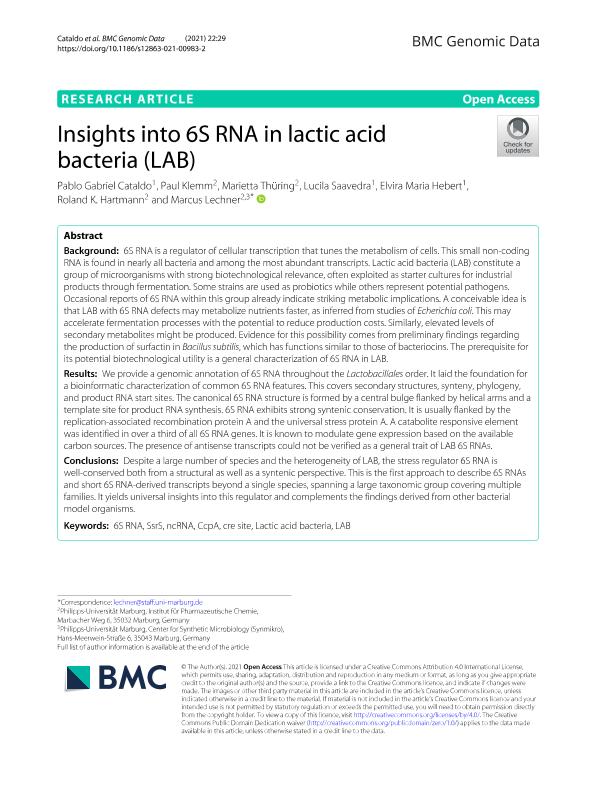Mostrar el registro sencillo del ítem
dc.contributor.author
Cataldo, Pablo Gabriel

dc.contributor.author
Klemm, Paul
dc.contributor.author
Thüring, Marietta
dc.contributor.author
Saavedra, Maria Lucila

dc.contributor.author
Hebert, Elvira Maria

dc.contributor.author
Hartmann, Roland K.
dc.contributor.author
Lechner, Marcus
dc.date.available
2022-10-18T11:42:36Z
dc.date.issued
2021-09-03
dc.identifier.citation
Cataldo, Pablo Gabriel; Klemm, Paul; Thüring, Marietta; Saavedra, Maria Lucila; Hebert, Elvira Maria; et al.; Insights into 6S RNA in lactic acid bacteria (LAB); BioMed Central; BMC Genomic Data; 22; 1; 3-9-2021; 1-15;29
dc.identifier.issn
2730-6844
dc.identifier.uri
http://hdl.handle.net/11336/173706
dc.description.abstract
Background: 6S RNA is a regulator of cellular transcription that tunes the metabolism of cells. This small non-coding RNA is found in nearly all bacteria and among the most abundant transcripts. Lactic acid bacteria (LAB) constitute a group of microorganisms with strong biotechnological relevance, often exploited as starter cultures for industrial products through fermentation. Some strains are used as probiotics while others represent potential pathogens. Occasional reports of 6S RNA within this group already indicate striking metabolic implications. A conceivable idea is that LAB with 6S RNA defects may metabolize nutrients faster, as inferred from studies of Echerichia coli. This may accelerate fermentation processes with the potential to reduce production costs. Similarly, elevated levels of secondary metabolites might be produced. Evidence for this possibility comes from preliminary findings regarding the production of surfactin in Bacillus subtilis, which has functions similar to those of bacteriocins. The prerequisite for its potential biotechnological utility is a general characterization of 6S RNA in LAB. Results: We provide a genomic annotation of 6S RNA throughout the Lactobacillales order. It laid the foundation for a bioinformatic characterization of common 6S RNA features. This covers secondary structures, synteny, phylogeny, and product RNA start sites. The canonical 6S RNA structure is formed by a central bulge flanked by helical arms and a template site for product RNA synthesis. 6S RNA exhibits strong syntenic conservation. It is usually flanked by the replication-associated recombination protein A and the universal stress protein A. A catabolite responsive element was identified in over a third of all 6S RNA genes. It is known to modulate gene expression based on the available carbon sources. The presence of antisense transcripts could not be verified as a general trait of LAB 6S RNAs. Conclusions: Despite a large number of species and the heterogeneity of LAB, the stress regulator 6S RNA is well-conserved both from a structural as well as a syntenic perspective. This is the first approach to describe 6S RNAs and short 6S RNA-derived transcripts beyond a single species, spanning a large taxonomic group covering multiple families. It yields universal insights into this regulator and complements the findings derived from other bacterial model organisms.
dc.format
application/pdf
dc.language.iso
eng
dc.publisher
BioMed Central

dc.rights
info:eu-repo/semantics/openAccess
dc.rights.uri
https://creativecommons.org/licenses/by/2.5/ar/
dc.subject
6S RNA
dc.subject
CCPA
dc.subject
CRE SITE
dc.subject
LAB
dc.subject
LACTIC ACID BACTERIA
dc.subject
NCRNA
dc.subject
SSRS
dc.subject.classification
Alimentos y Bebidas

dc.subject.classification
Otras Ingenierías y Tecnologías

dc.subject.classification
INGENIERÍAS Y TECNOLOGÍAS

dc.title
Insights into 6S RNA in lactic acid bacteria (LAB)
dc.type
info:eu-repo/semantics/article
dc.type
info:ar-repo/semantics/artículo
dc.type
info:eu-repo/semantics/publishedVersion
dc.date.updated
2022-09-20T18:54:31Z
dc.journal.volume
22
dc.journal.number
1
dc.journal.pagination
1-15;29
dc.journal.pais
Reino Unido

dc.journal.ciudad
Londres
dc.conicet.avisoEditorial
© The Author(s). 2021 Open Access This article is licensed under a Creative Commons Attribution 4.0 International License,
which permits use, sharing, adaptation, distribution and reproduction in any medium or format, as long as you give appropriate
credit to the original author(s) and the source, provide a link to the Creative Commons licence, and indicate if changes were
made. The images or other third party material in this article are included in the article’s Creative Commons licence, unless
indicated otherwise in a credit line to the material. If material is not included in the article’s Creative Commons licence and your
intended use is not permitted by statutory regulation or exceeds the permitted use, you will need to obtain permission directly
from the copyright holder. To view a copy of this licence, visit http://creativecommons.org/licenses/by/4.0/. The Creative
Commons Public Domain Dedication waiver (http://creativecommons.org/publicdomain/zero/1.0/) applies to the data made
available in this article, unless otherwise stated in a credit line to the data.
dc.description.fil
Fil: Cataldo, Pablo Gabriel. Consejo Nacional de Investigaciones Científicas y Técnicas. Centro Científico Tecnológico Conicet - Tucumán. Centro de Referencia para Lactobacilos; Argentina
dc.description.fil
Fil: Klemm, Paul. Universitat Phillips; Alemania
dc.description.fil
Fil: Thüring, Marietta. Universitat Phillips; Alemania
dc.description.fil
Fil: Saavedra, Maria Lucila. Consejo Nacional de Investigaciones Científicas y Técnicas. Centro Científico Tecnológico Conicet - Tucumán. Centro de Referencia para Lactobacilos; Argentina
dc.description.fil
Fil: Hebert, Elvira Maria. Consejo Nacional de Investigaciones Científicas y Técnicas. Centro Científico Tecnológico Conicet - Tucumán. Centro de Referencia para Lactobacilos; Argentina
dc.description.fil
Fil: Hartmann, Roland K.. Universitat Phillips; Alemania
dc.description.fil
Fil: Lechner, Marcus. Universitat Phillips; Alemania
dc.journal.title
BMC Genomic Data
dc.relation.alternativeid
info:eu-repo/semantics/altIdentifier/url/https://bmcgenomdata.biomedcentral.com/articles/10.1186/s12863-021-00983-2
dc.relation.alternativeid
info:eu-repo/semantics/altIdentifier/doi/http://dx.doi.org/10.1186/s12863-021-00983-2
Archivos asociados
